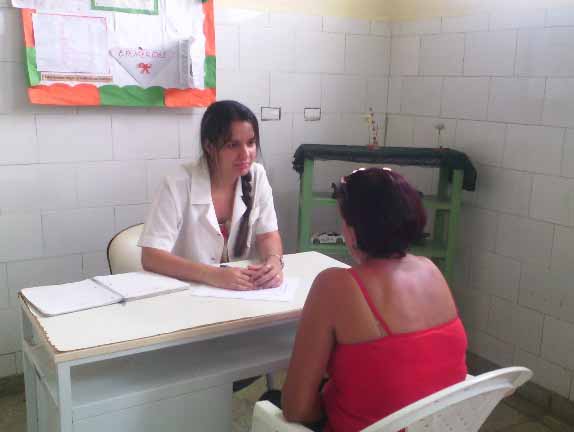Psychological repercussion of the hospital process in children with malignant hemopathies
Keywords:
ADAPTATION, PSYCHOLOGICAL, ANXIETY, FEAR.Abstract
Introduction: hospitalization is one of childhood stressors, whose most frequent negative repercussions are emotional alterations at short, medium and long term disruptive behaviors, which implies rendering the psychological repercussion of the hospital process in children with malignant diseases in order to determine the repercussion of hospitalization process in them.
Method: descriptive, cross-sectional, observational, non-experimental study with a qualitative design, with the application of psychological techniques.
Results: anxiety was manifested by means of fear of medical procedures, family ruptures and closed spaces; variations of the emotional state according to the perception of improvement. Mechanisms of defense as passive aggressiveness before the parents or physicians; regression, motor hyperactivity in children and sadness in adolescents were observed, as well as attitude to overcome the illness, the need to cooperate before the procedures for a better health. An attitude towards the disease was evidenced by their level of information and search for support in parents and medical personnel. An action guide is presented to perform the psychological work with these patients, both by the psychologist and the medical staff who assist them.
Conclusion: there is a need for help from relatives and patients to alleviate the psychological reactions that obstruct the hospital process. Psychological reactions related to the anxiety manifestations and to overcoming the disease were more frequently found. Intervention actions directed at parents and health personnel should be oriented according to the psychological reality of the patient.
Downloads
References
11. Ortigosa, J.; Méndez, F. “Hospitalización infantil. Repercusiones psicológicas”,
Biblioteca Nueva. Madrid, 2003 25(2): 8. Disponible en:
http://www.binasss.sa.cr/revistas/enfermeria/v25n2/8.pdf
2. Molina J.; Sagaseta de Ilúrdoz M.; Busto N.; et al. “Tratamiento del dolor en
pediatría hospitalaria”. ANALES. Sis San Navarra 20O2[citado 2017 jun 21]; 25(1): [Aprox.8p]. Disponible en: https://issuu.com/sep-pichincha/docs/vol.8_no.2-2007
3. Cruz, M. Fundamentos actuales de la terapéutica del dolor en Pediatría.
Conferencia. Boletín de la Sociedad de Pediatría de Asturias, Cantabria,
Castilla y León. 1999 [citado 2017 jun 21 39(169): 186-196. Disponible en: https://www.sccalp.org/documents/0000/0660/BolPediatr1999_39_186-196.pdf
4. Balleter Arnal, R. Guía práctica de psicología de la salud en el ámbito hospitalario. 2012. Disponible en: https://es.scribd.com/document/345875191/Guia-Psicologia-de-La-Salud-en-El-Ambito-Hospitalario
5. López Fernández M N, Alvarez Llanes Garcia. Aspectos psicológicos de la hospitalización infantil. Bol de pediatr [internet] .1995[citado 2017 jun 10];36:[Aprox.5.p.].Disponible en :
https://www.sccalp.org/documents/0000/1088/BolPediatr1995_36_235-240.pdf
6. García Morey A. Psicopatología Infantil, su evaluación y diagnóstico. Editorial Ciencias Médicas; 2006.
7. Izquierdo Sánchez, Beatriz. “Repercusión psicológica de la hospitalización en cuidados intensivos pediátricos en el adolescente y su familiar acompañante” Tesis de grado en opción al título de licenciatura en psicología de la salud. Universidad de ciencias médicas. Pinar del rio. Junio 2015.
8. López Naranjo I, Fernández Castillo A. Hospitalización infantil y atención psicoeducativa en contextos excepcionales de aprendizaje. Revista de Educación [internet] 2014 [citado sep-dic 2006]; 341:[Aprox.25p].Disponible en :
http://www.revistaeducacion.mec.es/re341_23.htm
9. Amstrong, George. “La hospitalización del niño”. Empiritus editors. 2001.
10. Díaz Quiñones J A. “Los linfomas como neoplasias hematológicas malignas: algunas reflexiones sobre aspectos éticos y sociales”. Gaceta Médica Espirituana[internet] 2004[citado 2004 sep-dic] ; 6(3).Disponible en :
http://bvs.sld.cu/revistas/gme/pub/vol.6.%283%29_06/p6.html
11. Harris, N L: World Health Organization Classification of Neoplastic Diseases of the Hematopeetic and Lymphoid Tisúes Repport of the Clinical Advisory.Committee Meeting—Airlie House, Virginia, November 1999. Disponible en:
http://ascopubs.org/doi/10.1200/JCO.1999.17.12.3835
12. López Naranjo, I. Alteraciones emocionales en la hospitalización infantil: análisis psicoevolutivo. Programa de doctorado: Intervención psicológica en contextos educativos y de desarrollo. Universidad de Granada 2011. Disponible en: https://hera.ugr.es/tesisugr/20314528.pdf
13. Alfaro Rojas A. K. Factores ambientales y su incidencia en la experiencia emocional del niño hospitalizado. Revista Pediatría Electrónica. Universidad de Chile [internet] 2013[citado 2017 jun 21];6(1):[Aprox.19.p.].Disponible en : http://www.revistapediatria.cl/vol6num1/4.html
14. Sierra P. Calidad de vida en el niño Hospitalizado. Revista de la
Sociedad Colombiana de Pediatría [internet].2000 [citado 2017 jun 21];34(2).Disponible en : https://encolombia.com/medicina/revistas-medicas/pediatria/vp-342/pediatria34299_calidad28/
15. Basilui, C & Sepúlveda, C. Juego Psicoterapéutico en niños hospitalizados de 8 a 11 años. Disertación de título no publicada, Universidad Diego Portales, Santiago, Chile. 2010.

Published
How to Cite
Issue
Section
License
Authors who have publications with this journal agree to the following terms: Authors will retain their copyrights and grant the journal the right of first publication of their work, which will be publication of their work, which will be simultaneously subject to the Creative Commons Attribution License (CC-BY-NC 4.0) that allows third parties to share the work as long as its author and first publication in this journal are indicated.
Authors may adopt other non-exclusive license agreements for distribution of the published version of the work (e.g.: deposit it in an institutional telematic archive or publish it in a volume). Likewise, and according to the recommendations of the Medical Sciences Editorial (ECIMED), authors must declare in each article their contribution according to the CRediT taxonomy (contributor roles). This taxonomy includes 14 roles, which can be used to represent the tasks typically performed by contributors in scientific academic production. It should be consulted in monograph) whenever initial publication in this journal is indicated. Authors are allowed and encouraged to disseminate their work through the Internet (e.g., in institutional telematic archives or on their web page) before and during the submission process, which may produce interesting exchanges and increase citations of the published work. (See The effect of open access). https://casrai.org/credit/


